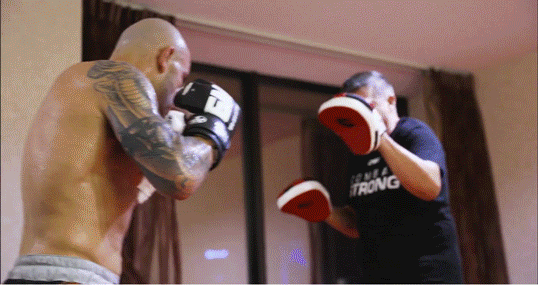Okay, so I finally had a chance to put on gloves and do a couple of rounds of medium contact sparring with one of our amateur boxers using the Jow Ga punching methods that
@JowGaWolf showed me during our workout. My sparring partner (Joe) has solid technique and is in great shape, but is at the beginning of his fight career and is someone I can handle comfortably using my regular boxing technique.
For purposes of learning, I made myself stick strictly to the moves JowGaWolf showed me and did not allow myself to dip into my normal boxing repertoire. I did not use any kicks, since my sparring partner has no experience with those. I did let my partner know that I would be trying out Kung Fu striking methods and that many of them would not be legal under standard boxing rules. We kept the power down to light/medium levels but we were going full speed and trying to be somewhat competitive.
Results:
For the first minute or so I was pretty much pounding on my partner at will, due to the surprise factor of the unorthodox technique. I tried to pull the punches as much as possible, but the body mechanics of the long fist style swings didn't afford me the fine control over contact that I have with my boxing punches. If we had been going full power without gloves or headgear, I would have had a good chance of knocking him out.
As he got used to the style of attack, he got progressively better at defending: slipping, rolling, ducking, blocking, intercepting, and countering. By the end of the second round, he was definitely outpointing me. Interestingly enough, he didn't come up with any new style of defense for dealing with the Jow Ga attacks. He kept to his standard boxing defense, but tightened it up significantly because he didn't want to get hit by more of those long fist haymakers. Honestly, it was some of the best head movement I've seen from him in sparring.
I was exhausted by the end of the first round, for a few reasons. Firstly, the techniques I was using were mostly power shots, since that's what I've learned of Jow Ga so far. I don't have the kind of cardio I used to, and throwing power shots continuously for two minutes against a partner who is more than 30 years younger than me is very tiring. Secondly, the techniques are new to me and I wasn't as relaxed and efficient as I am with my normal repertoire. Thirdly, I kind of forgot about the little bit of Jow Ga defense I had learned and was pretty much just attacking continuously for 2 rounds. Normally when I spar with Joe, I conserve my energy and just use potshots and counters.
Reflections afterwards:
I spotted a number of moments when my technique was sloppy, but given that I've had a total of one lesson and a little bit of solo practice, it was better than I expected.
I stuck to the same handful of combos that I had practiced previously, and that cost me in the second round once Joe got used to those and started to be able to read them. Afterwards I thought of more ways I could have mixed it up and been less predictable.
The Jow Ga attacks I've learned so far are mostly long range and I had been practicing them with aggressive footwork. This worked well in the beginning, but once Joe got the hang of slipping my strikes and moving in to counterattack at closer range, I started to have problems. Obviously it wouldn't have been a problem if I was allowing myself to use my normal repertoire, but it was awkward using only Jow Ga. Afterwards, I was able to figure out the sort of evasive footwork that I should have been using with the long fist strikes when he pressed forwards, but that's something I'll have to practice. Normally evasive footwork is my preference, but I just hadn't mentally connected it to this style of striking yet. (I'm sure JowGaWolf also has a close range striking toolbox, but I haven't learned those methods yet.)
Next time I need to remember to relax and try my normal defend and counter game while using the long fist strikes in order to not tire myself out. (In fairness, I had already done a few rounds of regular boxing sparring before I tried the Jow Ga, but still I was wasting way too much energy.)
In the long term, this sort of striking will work a lot better for me once it's integrated with the rest of my fighting repertoire. I'm already seeing some ways I could do that. But I want to practice it in isolation first in order to understand it better and work out my technical flaws.


